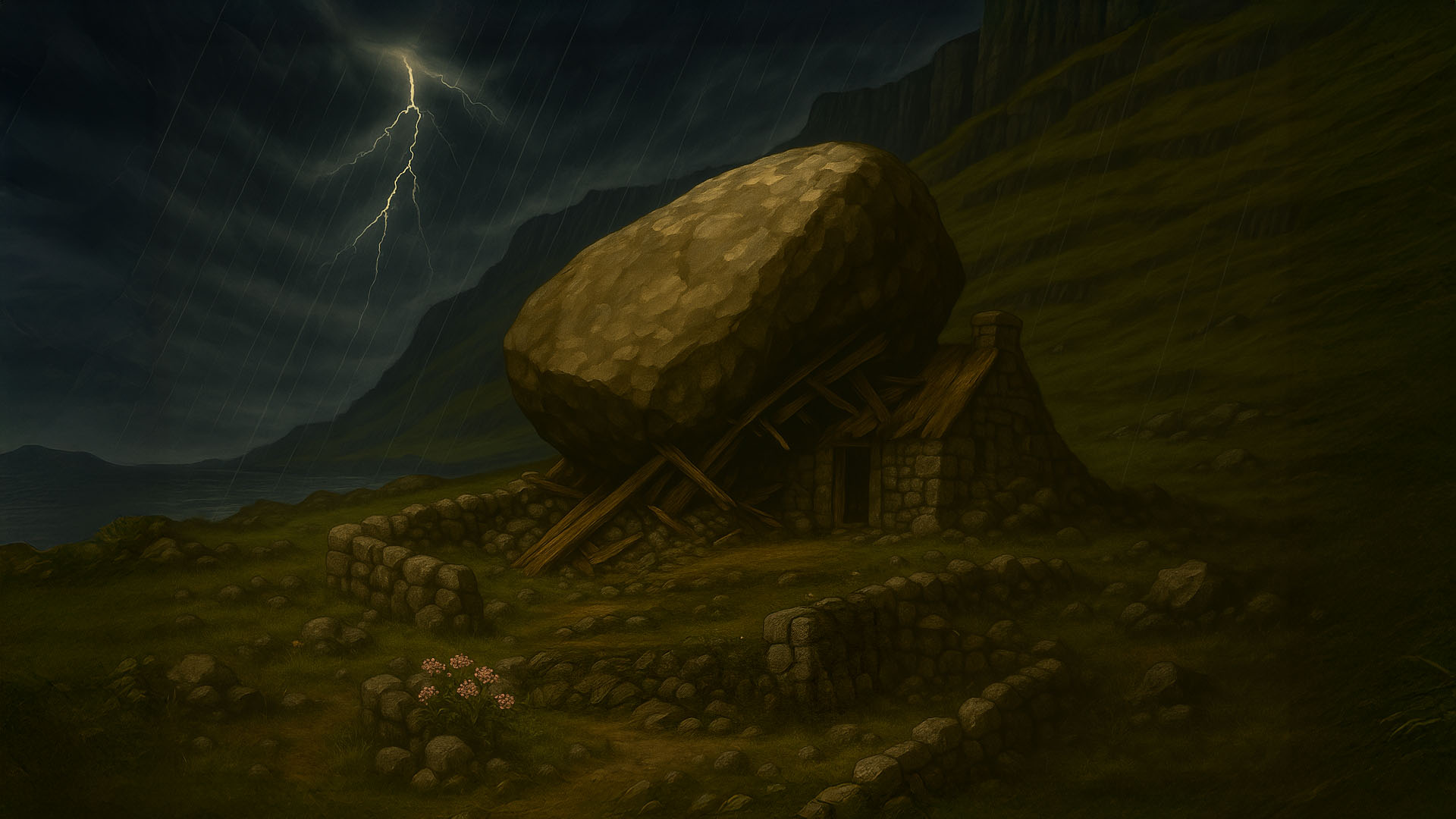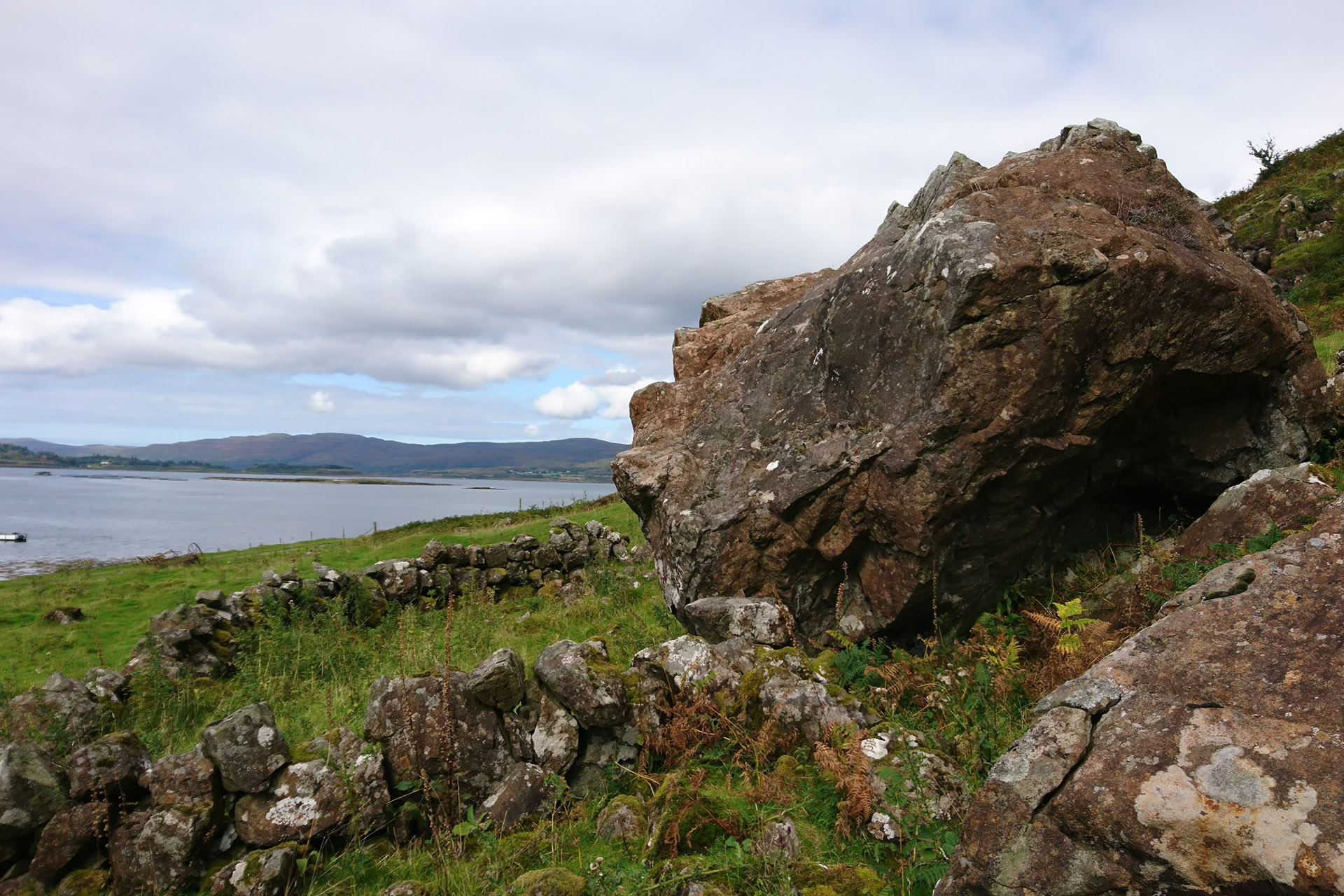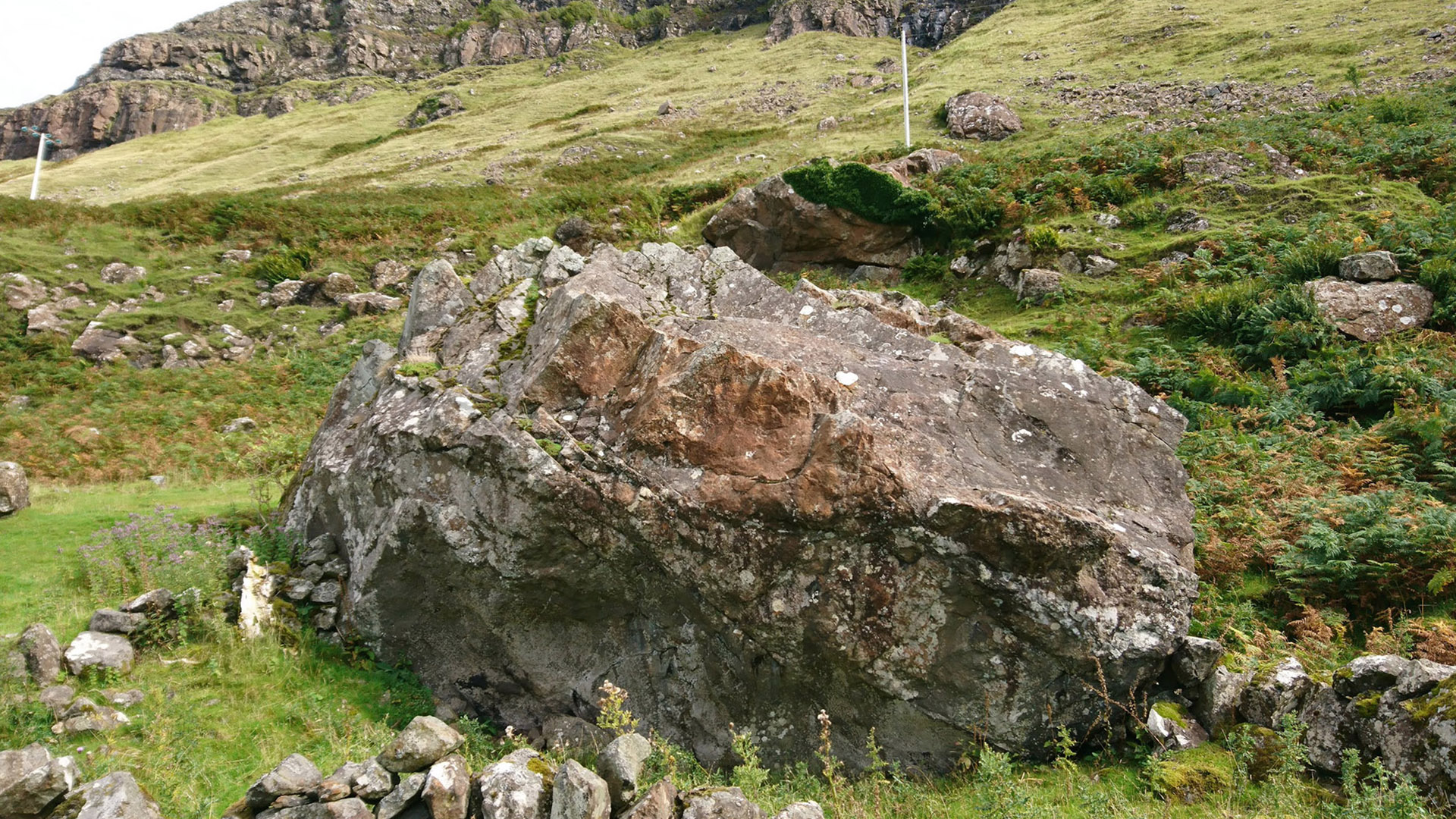Nestled on the rugged, windswept coast of the Isle of Mull, Scotland, lies a place where history, romance, and tragedy intertwine: Tragedy Rock, also known locally as Honeymoon Rock or Clach na Leannan (the Stone of the Courting Couple). This unassuming boulder at the foot of Gribun’s towering cliffs carries a heart-wrenching story that has captivated locals and visitors for centuries. For tourists seeking to uncover the soul of Mull’s wild landscape and rich folklore, Tragedy Rock is a poignant stop that blends natural beauty with a tale of love lost. This blog post dives deep into the legend, its geological and cultural significance, and why it’s an unmissable experience on this enchanting Hebridean island.

Tragedy Rock—where love bloomed and was buried beneath stone and storm.
The Legend of Tragedy Rock
The story of Tragedy Rock, set around the year 1700, is one of love, celebration, and devastating loss, etched into the dramatic landscape of Gribun. It centers on a young couple, John, a local shepherd, and Rona, the daughter of a blacksmith, whose love story ended in a tragedy that gave the rock its name.
John and Rona were deeply in love, their bond a source of joy in the close-knit Gribun community. After a heartfelt wedding celebration, the newlyweds settled into a small cottage at the base of the 1,000ft cliffs that dominate Mull’s western coast. The cottage, modest but filled with the promise of their new life together, stood in the shadow of the basalt cliffs, a seemingly serene spot. But on their wedding night, as the couple began their honeymoon, a fierce storm swept across the island. The wind roared, and torrential rain battered the cliffs, loosening a massive boulder high above.
In a catastrophic moment, the boulder broke free, tumbling down the cliff face and crashing onto the couple’s cottage. The impact was devastating, flattening the home and claiming the lives of John and Rona. The grief-stricken community was unable to recover the couple’s bodies from beneath the immense rock. For nearly two centuries, remnants of the cottage’s rafters were said to protrude from under the boulder, a haunting reminder of the tragedy. Today, a small garden with blooming flowers marks the site, tended by locals as a memorial to the couple whose love was cut short.
This tale, passed down through generations, has given the boulder its various names. Tragedy Rock reflects the sorrowful event, while Honeymoon Rock, a term cherished by many locals, emphasizes the couple’s newlywed joy before the disaster. The Gaelic name, Clach na Leannan, translates to “Stone of the Courting Couple,” capturing the romantic essence of their story. For tourists, this legend offers a window into Mull’s oral traditions, where stories of love and loss are woven into the very fabric of the landscape.

Tragedy Rock with remnants of a collapsed stone wall nestled around its base.
The Setting: Gribun’s Wild Beauty
Tragedy Rock is located at Gribun, on the south side of Loch na Keal, near Balmeanach Farm, just off the B8035 road. The site is marked by a distinctive windblown elder tree near the farm’s gable, making it easy to spot from the roadside. The rock lies about 50 yards inland, at the base of the sheer cliffs that define this part of Mull’s coast. These cliffs, rising to 1,000 feet, are a geological marvel, composed of Palaeocene basalt lava flows layered over Mesozoic sedimentary rocks and ancient Moine psammites from the Proterozoic era. The dramatic landscape, with its rugged cliffs and sweeping views, is part of Mull’s “Wilderness” region, a haven for adventurers and nature lovers.
The area’s rugged beauty is both awe-inspiring and humbling. As you stand before Tragedy Rock, you’ll feel the weight of the cliffs above and the vastness of Loch na Keal stretching out to the north. The views across the loch to the distant shores of Mull’s north coast are breathtaking, especially on a clear day when the light dances on the water. The site is also a prime spot for wildlife enthusiasts, with seals, otters, and sea eagles often visible in the loch or soaring overhead.
However, the cliffs’ beauty comes with a warning. The Gribun area is geologically active, with rockfalls a recurring risk, especially after heavy rain. The B8035 road was closed until August 2025 due to a recent landslip, with drone surveys planned to assess the hillside’s stability. This geological instability is a stark reminder of the forces that shaped the tragedy of John and Rona, making the rock not only a historical site but also a testament to nature’s unpredictable power.

Tragedy Rock of Gribun, its vast shape sunken in bracken and shadow. Below, the coastline stretches silent beneath a bruised sky, marked by loss and memory.
Why Visit Tragedy Rock?
For tourists, Tragedy Rock offers a unique blend of history, folklore, and natural splendor. Here are five reasons why it should be on your Isle of Mull itinerary:
- A Connection to Local Folklore: The story of Tragedy Rock is a cherished part of Gribun’s heritage, offering visitors a chance to connect with the island’s rich oral traditions. The tale of John and Rona resonates universally, speaking to themes of love, loss, and the fragility of life. As you stand by the rock, you can imagine the couple’s joy and the community’s grief, making it a deeply emotional experience. The small memorial garden, with its blooming flowers, adds a tender touch, inviting reflection on the enduring power of love.
- Stunning Natural Surroundings: The rock’s location at the foot of Gribun’s cliffs is a visual feast. The contrast between the towering basalt cliffs and the serene waters of Loch na Keal creates a dramatic backdrop that’s perfect for photography and contemplation. Whether you’re a hiker, a geologist, or simply someone who loves scenic views, the area around Tragedy Rock delivers. The nearby cliffs and shoreline are also home to diverse wildlife, making it a great spot for nature enthusiasts.
- A Glimpse into Mull’s Geology: For those interested in earth sciences, Tragedy Rock is a gateway to understanding Mull’s geological history. The cliffs are part of a volcanic landscape formed millions of years ago, with layers of basalt, sedimentary rock, and ancient psammites telling a story of tectonic upheaval. The rock itself, a product of a catastrophic fall, highlights the ongoing geological activity in the area. Visitors can appreciate how the same forces that shaped Mull’s dramatic terrain also played a role in the tragedy.
- Accessibility and Ease of Visit: Tragedy Rock is easily accessible from the B8035 road, making it a convenient stop for tourists exploring Mull’s west coast. The rock is visible from the roadside, and a short walk brings you closer to the site and its memorial garden. While the road’s recent closure due to a landslip may require checking local updates, the site’s proximity to the road makes it an easy addition to a day trip along Loch na Keal.
- A Moment of Reflection: In a world of fast-paced travel, Tragedy Rock offers a rare opportunity to pause and reflect. The story of John and Rona, combined with the quiet beauty of the memorial garden, invites visitors to consider life’s fleeting moments and the enduring power of love. It’s a place to slow down, take in the scenery, and connect with the human stories that make Mull so special.
Planning Your Visit
Getting There
Tragedy Rock is located near Balmeanach Farm, along the B8035 road on the south side of Loch na Keal. From Tobermory, the main town on Mull, it’s about a 30-minute drive southwest. The road is narrow and winding, with cliffs on one side and a drop to the sea on the other, so drive with caution. If you’re coming from Craignure, where the ferry from Oban arrives, it’s roughly a 40-minute drive west. Check local road conditions, as the B8035 was closed until August 2025 due to a landslip at Gribun Rocks. Public transport options are limited, so renting a car or joining a guided tour is recommended.
What to Expect
The Site: Tragedy Rock is a large boulder, easily spotted from the road due to its proximity to the elder tree and Balmeanach Farm. The memorial garden nearby is small but well-maintained, with flowers adding a colorful touch.
Safety: The cliffs above are prone to rockfalls, so avoid lingering directly beneath them, especially after heavy rain. Follow any posted signs or local advice regarding road and site safety.
Views: The location offers stunning vistas across Loch na Keal, with opportunities to see wildlife like seals, otters, and eagles. Bring binoculars and a camera for the best experience.
Weather: Mull’s weather can be unpredictable, with rain and wind common. Dress in layers, wear sturdy shoes, and bring waterproof gear.
Tips for Tourists
- Combine with Other Stops: Tragedy Rock is a quick stop, so pair it with other west coast highlights, such as a scenic drive along Loch na Keal, exploration of the majestic MacKinnon’s Cave or a visit to nearby viewpoints for wildlife spotting.
- Respect the Site: The memorial garden is a place of remembrance, so treat it with care and respect. Avoid picking flowers or disturbing the area.
- Learn the Local Names: While Tragedy Rock is the common name, locals may refer to it as Honeymoon Rock or Clach na Leannan. Using these names can spark conversations with residents and deepen your connection to the community.
- Photography: The rock and its surroundings are photogenic, especially at sunrise or sunset when the light casts a golden glow over Loch na Keal. Capture the elder tree and cliffs for a dramatic shot.
Cultural and Historical Context
Tragedy Rock is more than just a boulder; it’s a cultural touchstone for the Gribun community. The Isle of Mull is steeped in folklore, from tales of selkies and fairies to stories of clan battles and shipwrecks. Tragedy Rock fits into this tradition, serving as a reminder of the island’s harsh yet beautiful environment. The story of John and Rona reflects the challenges faced by Mull’s early inhabitants, who lived in harmony with—but at the mercy of—the island’s rugged terrain and unpredictable weather.
The rock’s multiple names highlight the fluidity of oral traditions. Honeymoon Rock, as many locals call it, emphasizes the romantic aspect of the couple’s story, while Clach na Leannan ties it to Gaelic heritage. These names show how the same place can hold different meanings for different people, making it a fascinating study in cultural storytelling.
For tourists, the rock offers a chance to engage with Mull’s living history. The memorial garden, tended by the community, is a testament to the story’s enduring impact. Visiting the site allows you to step into this narrative, connecting with the past in a way that feels immediate and personal.
Practical Information
Best Time to Visit: Spring and summer (April to September) offer milder weather and longer daylight hours, ideal for exploring the site and enjoying the views. Autumn and winter can be dramatic but come with stronger winds and rain.
Cost: Visiting Tragedy Rock is free, as it’s a public site along the roadside.
Facilities: There are no facilities directly at the site, but nearby Tobermory and Salen offer cafes, restrooms, and accommodations. Bring water and snacks for your visit.
Guided Tours: Some local tour operators include Gribun in their itineraries, often combining it with other west coast highlights. Check with Visit Mull or local guides for options.
Accessibility: The rock is visible from the road, making it accessible for most visitors. However, the short walk to the rock and garden may involve uneven terrain, so those with mobility issues should proceed with care.
Reflecting on Tragedy Rock
Visiting Tragedy Rock is more than just ticking off a tourist attraction; it’s an opportunity to connect with the heart of the Isle of Mull. The story of John and Rona, preserved in the boulder and its memorial garden, reminds us of the fragility of life and the enduring power of love. As you stand before the rock, with the cliffs looming above and the loch sparkling below, you’ll feel the weight of history and the beauty of Mull’s wild landscape.
For those seeking a deeper connection to Scotland’s Hebrides, Tragedy Rock is a must-visit. It’s a place where nature and human stories collide, leaving a lasting impression on all who hear its tale. So, pack your camera, lace up your walking boots, and head to Gribun to experience the haunting beauty of Tragedy Rock for yourself.
Step into a world where ancient legends breathe and history whispers from every stone. This enchanting book invites you on a captivating journey through the heart of Scotland's Inner Hebrides, a land steeped in magic and timeless tales.


